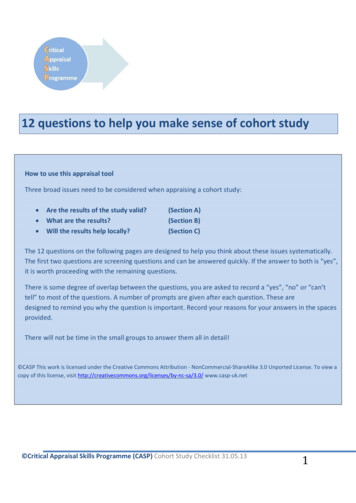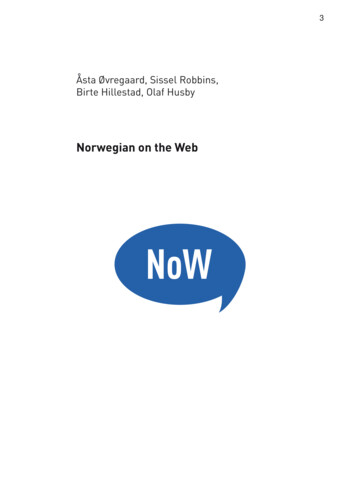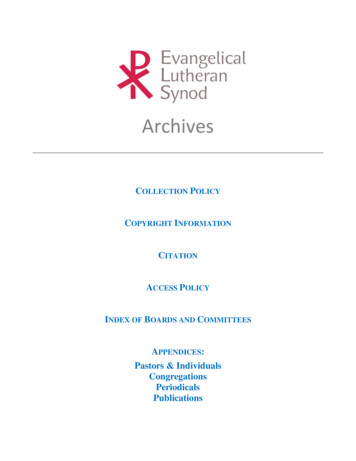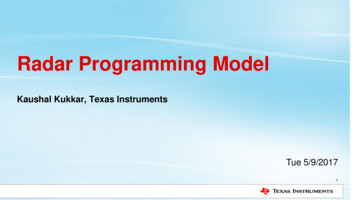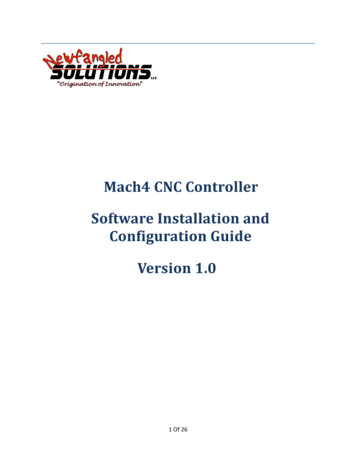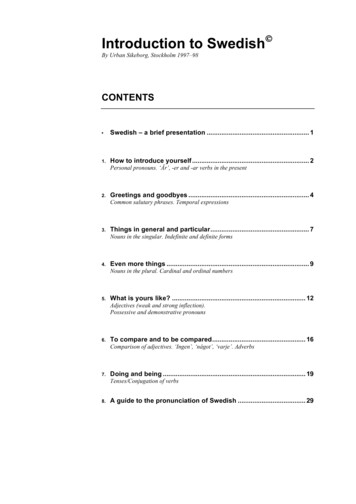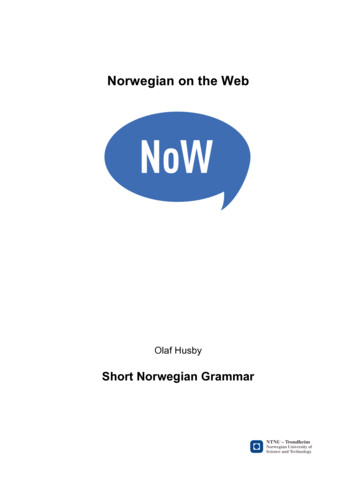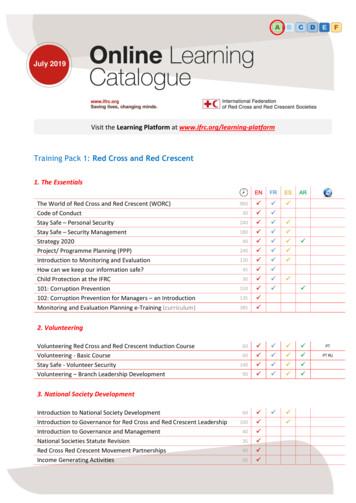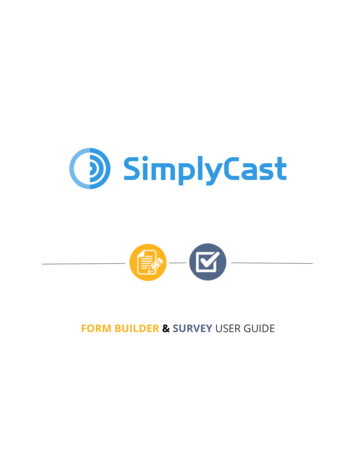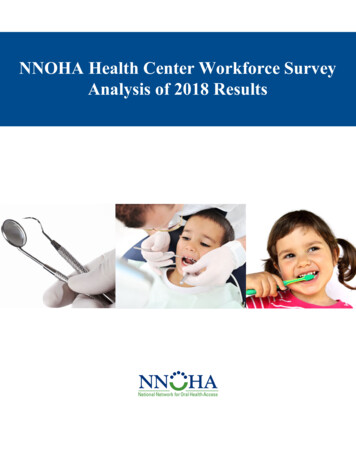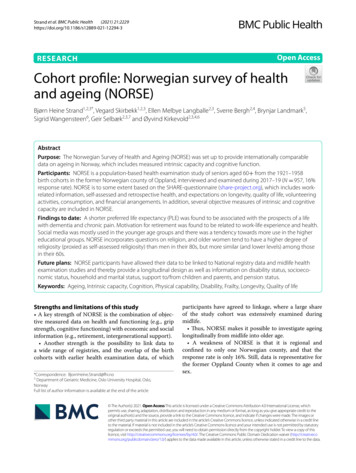
Transcription
(2021) 21:2229Strand et al. BMC Public en AccessRESEARCHCohort profile: Norwegian survey of healthand ageing (NORSE)Bjørn Heine Strand1,2,3*, Vegard Skirbekk1,2,3, Ellen Melbye Langballe2,3, Sverre Bergh2,4, Brynjar Landmark5,Sigrid Wangensteen6, Geir Selbæk2,3,7 and Øyvind Kirkevold2,3,4,6AbstractPurpose: The Norwegian Survey of Health and Ageing (NORSE) was set up to provide internationally comparabledata on ageing in Norway, which includes measured intrinsic capacity and cognitive function.Participants: NORSE is a population-based health examination study of seniors aged 60 from the 1921–1958birth cohorts in the former Norwegian county of Oppland, interviewed and examined during 2017–19 (N 957, 16%response rate). NORSE is to some extent based on the SHARE-questionnaire (share- proje ct. org), which includes workrelated information, self-assessed and retrospective health, and expectations on longevity, quality of life, volunteeringactivities, consumption, and financial arrangements. In addition, several objective measures of intrinsic and cognitivecapacity are included in NORSE.Findings to date: A shorter preferred life expectancy (PLE) was found to be associated with the prospects of a lifewith dementia and chronic pain. Motivation for retirement was found to be related to work-life experience and health.Social media was mostly used in the younger age groups and there was a tendency towards more use in the highereducational groups. NORSE incorporates questions on religion, and older women tend to have a higher degree ofreligiosity (proxied as self-assessed religiosity) than men in their 80s, but more similar (and lower levels) among thosein their 60s.Future plans: NORSE participants have allowed their data to be linked to National registry data and midlife healthexamination studies and thereby provide a longitudinal design as well as information on disability status, socioeconomic status, household and marital status, support to/from children and parents, and pension status.Keywords: Ageing, Intrinsic capacity, Cognition, Physical capability, Disability, Frailty, Longevity, Quality of lifeStrengths and limitations of this study A key strength of NORSE is the combination of objective measured data on health and functioning (e.g., gripstrength, cognitive functioning) with economic and socialinformation (e.g., retirement, intergenerational support). Another strength is the possibility to link data toa wide range of registries, and the overlap of the birthcohorts with earlier health examination data, of which*Correspondence: BjornHeine.Strand@fhi.no3Department of Geriatric Medicine, Oslo University Hospital, Oslo,NorwayFull list of author information is available at the end of the articleparticipants have agreed to linkage, where a large shareof the study cohort was extensively examined duringmidlife. Thus, NORSE makes it possible to investigate ageinglongitudinally from midlife into older age. A weakness of NORSE is that it is regional andconfined to only one Norwegian county, and that theresponse rate is only 16%. Still, data is representative forthe former Oppland County when it comes to age andsex. The Author(s) 2021. Open Access This article is licensed under a Creative Commons Attribution 4.0 International License, whichpermits use, sharing, adaptation, distribution and reproduction in any medium or format, as long as you give appropriate credit to theoriginal author(s) and the source, provide a link to the Creative Commons licence, and indicate if changes were made. The images orother third party material in this article are included in the article’s Creative Commons licence, unless indicated otherwise in a credit lineto the material. If material is not included in the article’s Creative Commons licence and your intended use is not permitted by statutoryregulation or exceeds the permitted use, you will need to obtain permission directly from the copyright holder. To view a copy of thislicence, visit http:// creat iveco mmons. org/ licen ses/ by/4. 0/. The Creative Commons Public Domain Dedication waiver (http:// creat iveco mmons. org/ publi cdoma in/ zero/1. 0/) applies to the data made available in this article, unless otherwise stated in a credit line to the data.
Strand et al. BMC Public Health(2021) 21:2229IntroductionThe Norwegian Survey of Health and Ageing (NORSE)was set up due to a lack of internationally comparabledata on ageing in Norway, which includes measuredintrinsic capacity and cognitive function. The WorldHealth Organization (WHO) defined in 2015 healthy ageing as an “ongoing process of developing and maintainingthe functional ability that enables well-being in older age”,and thereby shifting focus from diseases to functionalability, which is the interaction of the person’s intrinsiccapacity and their environment [1]. Of key importanceis collection of data on intrinsic capacity, and two suchindicators – delayed word recall and grip strength, withcomparable data from 36 countries were presented in thebaseline report for Decade of healthy ageing [2]. NORSEadds Norwegian data on these important indicators.Nationally representative surveys on health and ageing with harmonized tests and questions already covermore than half the world’s population, including HRS (forthe United States), SHARE and ELSA (for more than 20European countries), and SAGE (covering India, China,South Africa, Mexico, Ghana and Russia) [2, 3]. Norwaylacks a health and ageing survey that is harmonized withthese surveys - which includes capacity tests and questions that is comparable with these surveys. These ageingsurveys allow us to have comparable data in a comprehensive standardized fashion on intrinsic capacity, as well asphysical health, frailty and disability status, mental health,chronic conditions, cognition, living arrangements, ability to take care of oneself, work and pensions, risky healthbehaviour, such as alcohol use and smoking, family relations, and economic situation. NORSE complementsthe The Norwegian Life Course, Ageing and GenerationStudy (NorLAG), which is based on self-reports and registry linkage, lacking objective measures of function andcapacity [4]. NORSE also complements the large population based Tromsø study [5] and HUNT study [6], by theinclusion of questions specific to ageing, not included inthese studies, such as expectations on longevity.In Norway, administrative registers can be linked tothe data by the unique personal identification numberand provide information on disability, diseases, mortality,socioeconomic position, pension, marital status, supportfrom children and parents, and more. Moreover, the longitudinal dimension in NORSE will follow from linkingobjective tests from several life-course stages, includingextensive mid-life health examinations from the Norwegian Counties Study performed by The National MassRadiography Service (35–49 year olds, both genders,up to three waves, tested 1976–88) [7], which is largelyoverlapping with our birth cohorts. NORSE is a collaborative effort between Department of Health SciencesGjøvik NTNU, the Norwegian Institute of Public Health,Page 2 of 7the Norwegian National Advisory Unit on Ageing andHealth, and Innlandet Hospital Trust.NORSE is a health examination of seniors from the1921–1958 birth cohorts in the former Norwegian countyof Oppland, where 4% of the Norwegian population lives,and will accommodate the lack of data on birth cohortswhich can be followed over the adult life cycle. Opplandwas one of 19 Norwegian counties until January 1st 2020,when Oppland and Hedmark were merged into Innlandet county. Oppland county was situated north of Oslo,it had 189,545 inhabitants in 2019 (4% of the total Norwegian population), consisted of 26 municipalities, andLillehammer as the administrative center [8]. The countywas mostly rural, with farming and forestry as importantcontributors to the economy, and in recent years, tourismwas also an important contributor. Immigrant populationwas 9.5% in 2019 (25.2% in Oslo), and the population wasthe second oldest county with 28% 60 year olds in 2019(17% in Oslo) [8]. Among the 60 population of Oppland0.6% emigrated during 2019 compared to 0.7% in Norwayand 1.6% in Oslo [8].We performed a pilot study in 2014, where we testedout the data collection strategy. Based on the positivefeedback from this pilot the full-scale survey was conducted 2017–2019. The time lag between the pilot andthe full survey was due to lack of funding, and logistics.Similar to the pilot, the full-scale survey included faceto-face-interviews to gather objective measurements onphysical and cognitive performance, as well as anthropometric measures, and blood pressure. A questionnairewas used, which includes measurements on a range ofhealth, social, economic, household, and demographicinformation. The questionnaire is compatible with otherEuropean, and non-European surveys, of ageing, and itwas based on the harmonized SHARE version 5 (share- proje ct. org) questionnaire. The questions include workrelated information, self-assessed and retrospectivehealth, and expectations on longevity, quality of life, volunteering activities, consumption, and financial arrangements. See appendix for list of variables included in bothSHARE (version 5) and NORSE. Administrative registerswill be linked to the data by the unique personal identification number and provide information on disabilitystatus, socioeconomic status, household and marital status, support to/from children and parents, and pensionstatus. A key strength of NORSE is the combination ofdata on health and functioning with economic and socialinformation (e.g., retirement, intergenerational support).Cohort descriptionThe cohort includes a sample of participants aged60 years and above living in the former county of Oppland, Norway [8].
Strand et al. BMC Public Health(2021) 21:2229Page 3 of 7Sampling schemeThe Norwegian Tax Administration gave permissionto draw a random sample from the National Population Register of N 6000 participants aged 60 years andabove residing in the former county Oppland. The datawas collected over a period of 3 years, during the monthsFebruary and March in 2017, 2018 and 2019, and ineach of these years, an age stratified, random sample ofn 2000 was drawn without replacement. The total sample summed up to N 5981 unique individuals, as 19participants lacked a valid address and were removed.Each of the drawn individuals were assigned a uniqueNORSE ID-code, and the bridge linking this code withthe personal identification number is stored at the Norwegian Institute of Public Health, apart from all data,and without access for the NORSE project group. Thethree age strata were 60–69, 70–79 and 80 years, withequal numbers drawn from each age group, and therebyachieving oversampling of the older age groups (Table 1).Age on January 1st the 3 years was used.Recruitment strategyTo raise awareness of the study, local newspapers andradio were approached and they had coverage of thestudy the week before start of recruitment [9]. Eligibleparticipants were mailed, in regular post, a four-pageleaflet and invitation letter with detailed description ofthe study aims, the testing procedures, and how datawould be handled after the data collection. The leafletcontained ethical clearances and consent procedure, aswell as how participants later could withdraw their consent at any time. Those willing to participate could eitherTable 1 Study population and population in Oppland Countyper January 1st 2017, by sex, age and education (N 957)TotalNORSE Study populationaOppland County,January 1st %70–7938140,2%17,15833,3%80 ,2%Age groupsEducationa9 had missing information about age/sex and 40 for education. When linked tothe Population registry information will be updated for these participantssend a mobile text message, or sign up using a pre-paidletter. Two weeks after the initial invitation letter wereposted, a reminder was mailed to non-responders. Atotal of 957 out of 5981 invited participated in the interviews and health examinations (16%).Data collectionA pilot study was performed in 2014, where the data collection strategy was tested out. Both in the pilot studyand in the full study, final-year nursing students atDepartment of Health Sciences Gjøvik, who were specifically trained for the data collection, contacted the participants and scheduled a physical meeting for interview andexamination, either at home or in local healthcare clinicsor offices. At the time of testing, the respondents signedan informed consent. The full study was performed over3 years, with three cohorts of final year nursing studentscollecting the data; in 2017, 87 nursing students had 1–13interviews each (median 4), in 2018, 105 nursing studentshad had 1–8 interviews (median 2), and in 2019, 110 students performed 1–6 interviews (median 3). Comparableinterviews and data collections have been performed inother studies, and we had positive experiences from ourpilot-study. In a US study of more than 5000 participantsaged 71 years and older, the same physical performancebattery (SPPB) we used in NORSE was used and no injuries resulted from the administration of the performancetests [10]. The same applied to the NORSE pilot and mainstudy. During the interview, all data was written into astandardized protocol by the nursing student. The datawere later scanned and cleaned and transferred into thestatistical software SPSS. Further data cleaning and filepreparation was done in SPSS and Stata. Finally, a harmonised data file, containing data from all 3 years wasprepared.Sample size and response ratesAmong the 5981 sampled 60 year olds, 957 participated and the overall response rate was 16%, with higherresponse in the youngest age groups 60–69 years and70–79 years (both 19%) compared with the older agegroup 80 (9%). Number of respondents during the 3years were 342 (17%) in 2017, 321 (16%) in 2018 and 294(15%) in 2019, respectively. NORSE participants includedbirth cohorts (bc) born during 1921–58. The sample in2017 covered bc 1921–56 with age range 60–95 years atstudy, while the sample drawn in 2018 covered bc 1921–57 with age at study 60–96 years, and finally in 2019 thebc was 1922–58 with age at study 60–96 years. Samplingduring the 3 years was performed without replacement.Hence, the same person could be included only once. TheNORSE sample is representative regarding age and sex,but response rate was higher among those with higher
Strand et al. BMC Public Health(2021) 21:2229Page 4 of 7education (Table 1), and it is likely that we have a healthyselection bias.activity, smoking, alcohol use, work-life and workingactivity.How often will they be followed up?No additional data collection is planned in NORSE, butthe participants have consented for linkage to a widerange of national registry data and to earlier health surveys in the former Oppland County. Of special interest is the earlier population-based health examinationstudies in Oppland County, which took place three decades prior to NORSE. Most of the NORSE study participants have also participated in the Oppland Countystudy (see Table 2). Thus, it will be possible to constructa longitudinal study with two or more repeated measurements, where the same individuals are measuredboth in midlife and in older age. During 1976–78 allmen and women aged 35 to 49 years, living in OpplandCounty were invited to a cardiovascular health survey[7]. The participants were re-invited to similar followup surveys in 1981–83 and 1986–88, in addition torefresher samples. In total, 28,068 persons 35–49 yearsold were invited and 25,851 participated (92%). Thesewere born 1925–41 and largely overlapping the NORSEbirth cohorts born 1921–58. Similar procedures andquestionnaires were used in the 40-years old surveys(“40-årings undersøkelsene”) in 1991, and in 1997–98in Oppland County, where 40–42 years old were invitedin 1991 and 7820 in 1997–98 (N 13,196). These wereaged 60–70 years in 2017 [11]. Linkage has not yet beenperformed, but based on numbers in Table 2, we estimate that 58% of the NORSE participants participatedin one or more of these previous health examinationstudies. Variables, which is on file at Norwegian Institute of Public Health, are measured height, weight,blood pressure, cholesterol level, triglycerides, bloodglucose, and self-reports on time since last meal, historyof heart disease and diabetes and/or symptoms, physicalWhat has been measured?The full-scale NORSE survey included face-to-faceinterviews and health examination to gather validatedobjective measurements on physical and cognitivecapacity, as well as anthropometric measures (height,weight, and waist circumference), and blood pressure(see Table 3). In addition, self-reported validated questionnaire data includes measurements on a range ofhealth, social, economic, household, and demographicinformation. The questionnaire is compatible with otherEuropean (and non-European surveys) of ageing, and itis based on the harmonized SHARE (share- proje ct. org)questionnaire. The questions include rich work- and pension related information, education (own and spousal),marital status, information on siblings and children/grandchildren, volunteering activities, travel distance torelatives, social contact with friends and relatives, socialmedia use, financial arrangements, risk factors such asinactivity, smoking and alcohol use, self-assessed andretrospective physical and mental health, ADL, vision,hearing, diseases, medicine use, quality of life, loneliness, health services use. In addition, NORSE includesunique questions on expectations on longevity and preferred life expectancy (Table 3) [12]. NORSE has information about whether a proxy was present and helpedto answer the questions or interfered the interview.Furthermore, the interviewers provided information onwhether the respondent understood the questions andwhether there was fatigue during the interview. Danishand Swedish translations of the SHARE-questionnaireexist, and these were used with the original English version to make a Norwegian translation. Full populationdata from the former county of Oppland for year 2017by age, sex and education provided by Statistics NorwayTable 2 Previous health examination studies in Oppland during 1970s – 990 s, which can be linked to NORSECountyYearCounties StudyOpplandWave I: 1976–8Counties StudyOpplandWave II: 1981–3Invited (N)N 28,068–Participated(%)**Birth cohortAge at surveyAge in 6–92Counties StudyOpplandWave III: 1986–8–87%1925–4145–6376–9240-year surveysOppland1991N 13,19673%1947–5140–4266–7040-year surveysOppland1993–440-year surveysOppland1997–8N 7532N 0–62Source: https:// www. fhi. no/ div/ helse under sokel ser/ lands omfat tende- helse under sokel ser- lhu/ helse under sokel ser/ fylke sunde rsoke lsene-i- finnm ark- sog/** Estimated from page 66–67 from this report https:// www. fhi. no/ globa lasse ts/ dokum enter filer/ studi er/ helse under sokel sene/ overs ikt- over- fylker- og- arsku ll- 40- aring sunde rsoke lser. pdfBased on numbers in Table 2 (92% of the birth cohort 1925–41, 73% of the 1947–54 cohorts and 68% of the 1955–57 cohorts participated) we estimate that 553 (58%)NORSE participants will have participated in one or more of these previous health examination studies in the former county of Oppland
Strand et al. BMC Public Health(2021) 21:2229Page 5 of 7Table 3 Overview over measures in NORSESocioeconomic status and demography:Housing, number of stairs at main entrance, education, income, marital status, spouse education,age and birth year of parents, residency of parents, employment/working situation, type ofemployment, age at retirement, reason for retirement, feelings after retirement, job satisfaction.Social contact and assistance:Social contact with parents, provision of help to/from parents, siblings, children, social contact with children/grandchildren, provision of help to/from children/grandchildren, social contact with friends.Health and physical function (self-reported): Self-reported health status, parents health, longstanding limiting illness which affects functions in dailylife, diseases, medications, symptoms, vision, hearing, hearing aid, pADL, iADL, depression (EURO-D scale)[20], anxiety (Generalized Anxiety Disorder Screener, GAD-7) [21], sleep quality, vitality, subjective age,subjective life expectancy, preferred life length, hypothetical conditions affecting preferred life length.Anthropometrics (measured):Systolic and diastolic blood pressure x 2, pulse, height, weight, waist circumference, arm circumferenceIntrinsic capacity (measured):Grip strength (JAMAR dynamometer), Short physical performance battery (SPPB, the official Norwegianversion [22]) (standing balance, walking speed, chair rise test), one-leg standing balance (eyes open/closed) [23, 24], Montreal Cognitive Assessment (MoCA) [25], 10-word memory test (immediate anddelayed recall), Cognitive Function Screening Instrument (MCFSI) (KFI) self-reported [26].Health related factors:Smoking, snus, alcohol use, physical activity, loneliness, volunteering, leisure activities.Health services use:Use of general practitioner, medical specialist by type, dentist, nursing home, home based care.Other:Religiositywas used to create population weights, which can beapplied to control for selection bias.Findings to dateNORSE data has only recently been available for researchand therefore output is limited, and publications arerestricted to one peer reviewed research paper in thejournal Age and Ageing, a master thesis, and three conference abstracts. Preferred life expectancy (PLE) wasfound to be associated with hypothetical adverse life scenarios among Norwegians aged 60 [12]. Especially theprospects of a life with dementia and chronic pain wasassociated with shorter PLE. Furthermore, in preliminarywork on health and function after retirement, presentedat the Nordic Congress on Gerontology 2021 (NKG25),it was reported that those who were motivated to retiredue to the good Norwegian public pension schemes andto enjoy life had a better work-life experience and alsobetter self-reported health after retirement than thosewho retired due to poor health or being tired of work[13]. Another, presentation at NKG25 investigated socialmedia use in the elderly, and reported more use in theyounger age groups and a tendency towards more use inFig. 1 Mean walking speed (meters per second) by age and sex. Number of participants: 298. Age trend: p 0.01 for both men and women
Strand et al. BMC Public Health(2021) 21:2229Page 6 of 7Fig. 2 How religious would you describe yourself on a scale of 0–10? (of which 10 are most religious). Mean values by age and sex. Number ofparticipants: 297. Age trend: women p 0.01; men p 0.59the higher educational groups [14, 15]. Quantification ofthe feasibility using nursing students for data collectionin the NORSE pilot study was presented at the NordicCongress on Gerontology 2014 (NKG22) in Gothenburg,Sweden [16].We include two graphs, exemplifying findings fromNORSE on one measure of physical functioning (pace ofwalking) and one social variable (self-assessed religiosity).Pace of walking: Walking speed among older individuals may predict the risk of several health outcomes,including all-cause mortality [17]. Evidence fromNORSE, see Fig. 1, reveals a lower walking speed amongthose in their 70s and 80s compared to those in their 60s;and that the age-related variation in walking speed isstronger for women.Belief in God: Religious beliefs have been found to beassociated with health and demographic outcomes [18,19]. NORSE incorporates questions on religion – Fig. 2shows that older women tend to have a higher degree ofreligiosity (proxied as self-assessed religiosity) than menin their 80s, but more similar (and lower levels) amongthose in their 60s.Strengths and limitationsA key strength of NORSE is the combination of objectivemeasured data on health and functioning with economicand social information (e.g., retirement, intergenerational support). Another strength is the possibility to linkdata to a wide range of registries, and the overlap of thebirth cohorts with earlier health examination data, ofwhich participants have agreed to linkage, where a largeshare of the study cohort was extensively examined during midlife. Thus, NORSE makes it possible to investigate ageing longitudinally from midlife into older age.A weakness of NORSE is low response rate. Still, data isrepresentative when it comes to age and sex.Supplementary InformationThe online version contains supplementary material available at https:// doi. org/ 10. 1186/ s12889- 021- 12294-3.Additional file 1.AcknowledgementsThanks to all the participants and the 302 nursing students for participating in the NORSE training and data collection. We are grateful to NTNUGjøvik for facilitating the data collection and training of nursing students.We thank Erlend Kirkevold for data cleaning and preparation of the NORSEdata file.Authors’ contributionsBHS, VS, EML, SB, BL, SW, GS, ØK participated in planning and designingthe study. BHS drafted the paper, which was revised critically for importantintellectual content and approved by all authors. Authors are in agreementto be accountable for all aspects of the work in ensuring that questionsrelated to the accuracy or integrity of any part of the work are appropriately investigated and resolved. All authors have read and approved themanuscript.FundingThe NORSE study is funded by Department of Health Sciences Gjøvik NTNU,the Norwegian Institute of Public Health, the Norwegian National AdvisoryUnit on Ageing and Health, and Innlandet Hospital Trust.
Strand et al. BMC Public Health(2021) 21:2229Availability of data and materialsTo get access to NORSE data for medical research, each project will need aspecific clearance from the Regional Ethics Committee (REC) and the NORSEproject group. The REC application and REC approval is sent to the NORSEstudy along with an application. More information is found at the NORSE website at the Norwegian Institute of Public Health: https:// www. fhi. no/ studi er/ norse- studi en/.DeclarationsEthics approval and consent to participateAll participants has given a written informed consent. NORSE was assessed bythe Norwegian Regional Ethics Committee for medical research (REC), whichin a decision of 25.06.2015 (2015/970/REK south-east) concluded that thetreatment involves the establishment of a health register and that the projecttherefore falls outside the scope of the Health Research Act. An application was therefore made for a license pursuant to section 7 of the HealthRegister Act, cf. section 33 of the Personal Data Act. This license was granted18.10.2016, and NORSE was then officially defined as a health registry, and thestudy, including all experimental protocols, were approved by the Norwegiandata inspectorate (Reference number 16/00929–2/GRA). All methods werecarried out in accordance with relevant guidelines and regulations.Consent for publicationAll participants has given a written informed consent for publication.Competing interestsNone declared for all authors.Author details1Norwegian Institute of Public Health, P.O. Box 222 Skøyen, 0213 Oslo, Norway.2Norwegian National Advisory Unit on Ageing and Health, Vestfold HospitalTrust, Tønsberg, Norway. 3 Department of Geriatric Medicine, Oslo UniversityHospital, Oslo, Norway. 4 Research Centre for Age‑related Functional Declineand Disease, Innlandet Hospital Trust, Brumunddal, Norway. 5 Norwegian PolarInstitute, Tromsø, Norway. 6 Department of Health Science Gjøvik, Facultyof Medicine and Health Sciences, NTNU, Gjøvik, Norway. 7 Faculty of Medicine,University of Oslo, Oslo, Norway.Received: 19 August 2021 Accepted: 15 November 2021References1. Beard JR, Officer A, de Carvalho IA, et al. The World report on ageing and health: a policy framework for healthy ageing. Lancet2016;387(10033):2145–2154. doi: https:// doi. org/ 10. 1016/ s0140- 6736(15) 00516-4 [published Online First: 2015/11/02].2. WHO. Decade of healthy ageing: baseline report. Geneva, Switzerland:World Health Organization (WHO), 2020.3. Sanchez-Niubo A, Forero CG, Wu YT, et al. Development of a commonscale for measuring healthy ageing across the world: results from theATHLOS consortium. Int J Epidemiol 2020 doi: https:// doi. org/ 10. 1093/ ije/ dyaa2 36 [published Online First: 2020/12/05].4. Veenstra M, Herlofson K, Aartsen M, et al. Cohort Profile: The NorwegianLife Course, Ageing and Generation Study (NorLAG). Int J Epidemiol2021;50(3):728-29i. doi: https:// doi. org/ 10. 1093/ ije/ dyaa2 80 [publishedOnline First: 2021/01/27].5. Jacobsen BK, Eggen AE, Mathiesen EB, et al. Cohort profile: the Tromsostudy. Int J Epidemiol. 2012;41(4):961–7.6. Krokstad S, Langhammer A, Hveem K, et al. Cohort Profile: the HUNTStudy, Norway. Int J Epidemiol 2013;42(4):968–77. doi: https:// doi. org/ 10. 1093/ ije/ dys095 [published Online First: 2012/08/11].7. Bjartveit K. The cardiovascular disease study in Norwegian counties. Oslo,1983.8. Norway S. Stat bank Population count 2019 [Available from: https:// www. ssb. no/ en/ befol kning/ folke tall accessed September 30th 2021.9. Dale TG. NTNU-forsker vil finne ut hvordan de eldre i Oppland har det.Oppland Arbeiderblad 2016 09.12.2016.Page 7 of 710. Guralnik JM, Simonsick EM, Ferrucci L, et al. A short physical performancebattery assessing lower extremity function: association with self-reporteddisability and prediction of mortality and nursing home admission. JGerontol. 1994;49(2):M85–94.11. L
sive standardized fashion on intrinsic capacity, as well as physical health, frailty and disability status, mental health, chronic conditions, cognition, living arrangements, abil - ity to take care of oneself, work and pensions, risky health behaviour, such as alcohol use and smoking, family rela-tions, a
